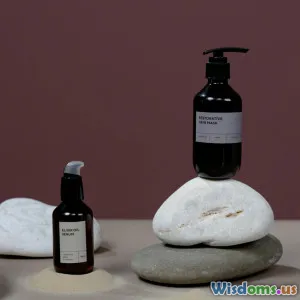
Are Natural Fragrances Really Safer for Sensitive Skin
9 min read Exploring the truth behind natural fragrances and their safety for sensitive skin. (0 Reviews)
Are Natural Fragrances Really Safer for Sensitive Skin?
In the world of skincare and personal care products, the allure of "natural" ingredients has become almost irresistible. This trend extends to fragrances: consumers often believe that natural fragrances—extracted from flowers, herbs, and fruits—are gentler and safer, especially for those with sensitive skin. But is this belief backed by science, or is it a marketing myth?
Sensitive skin, characterized by redness, itching, burning, or dryness, can react unpredictably to various chemicals, making fragrance choice an important consideration. This comprehensive article examines whether natural fragrances are truly safer alternatives, the underlying chemistry of fragrance allergens, and practical guidance to help you make informed choices.
Understanding Sensitive Skin and Fragrance
What Constitutes Sensitive Skin?
Sensitive skin is not just a marketing term; it has physiologic and immunologic bases. Individuals with sensitive skin tend to have a compromised skin barrier, making them more vulnerable to irritants and allergens. Common symptoms include burning, stinging, itching, and redness after product application.
According to the American Academy of Dermatology, nearly 60% of the population experiences some form of sensitive skin at some point.
How Fragrances Affect Sensitive Skin
Fragrances—whether synthetic or natural—contain complex mixtures of chemical compounds. Many of these compounds can act as irritants or allergens. The reaction can range from mild irritation to allergic contact dermatitis, which can be persistent and hard to treat.
The key lies in the chemical nature of these compounds rather than their origin. Both synthetic and natural compounds can trigger skin reactions in susceptible individuals.
Natural Fragrances: Definitions and Components
What Are Natural Fragrances?
Natural fragrances are scent ingredients derived from botanical sources including flowers, leaves, roots, fruits, and woods through processes like steam distillation or solvent extraction.
Examples include:
- Lavender oil
- Rose absolute
- Citrus peel extracts
Composition and Complexity of Natural Fragrances
Plants produce hundreds of volatile organic compounds to attract pollinators or fend off pests. Some of these include terpenes, esters, aldehydes, and phenolic compounds—all contributors to scent.
While natural, these compounds are bioactive—and many are known allergens or irritants. For example, limonene and linalool, common in citrus and lavender oils, can oxidize and form allergenic compounds.
Comparing Natural and Synthetic Fragrances
Synthetic Fragrances: What Are They?
Synthetic fragrances are mixtures of man-made chemicals designed to mimic natural scents or create entirely novel ones. Manufacturers may use synthetic formulas to ensure consistency, cost-effectiveness, and to reduce allergenic components.
Are Synthetic Fragrances Less Likely to Cause Irritation?
Not necessarily. Synthetic fragrances contain allergens such as synthetic musks (e.g., galaxolide) which have been implicated in skin sensitization. Moreover, some synthetic chemicals may be irritants or disrupt the skin barrier.
However, certain synthetics are designed to be hypoallergenic, with some formulations excluding the top known fragrance allergens outlined by the International Fragrance Association (IFRA).
Common Allergenic Fragrance Ingredients
Natural Fragrance Allergens
The European Union’s list of 26 fragrance substances known to cause contact allergies includes many natural compounds:
- Limonene: Found in citrus oils, can oxidize to form sensitizers.
- Linalool: Present in lavender and coriander oils.
- Geraniol: Found in rose and palmarosa oils.
These compounds are part of the mandatory labeling repertoire in many countries when above a threshold.
Synthetic Fragrance Allergens
Synthetic ingredients such as eugenol, cinnamal, and isoeugenol, used to mimic natural scents, are also common allergens.
What Does Science Say? Dermatology Insights
Studies on Natural Fragrance Allergens
Research published in the Journal of the American Academy of Dermatology shows that natural essential oils can cause allergic contact dermatitis similar to synthetic fragrances. In fact, some studies report that essential oil allergy prevalence ranges from 2% to 6% in eczema patients.
Expert Opinion
Dr. Jane Grant-Kels, esteemed dermatologist, explains, “Natural does not mean non-allergenic. Some of the most potent allergens are botanical-derived.” She recommends patch testing for fragrance allergy regardless of product type.
Regulatory Perspectives
The IFRA regulates fragrance ingredient usage and sets limits to reduce allergy risks. They emphasize allergen disclosure and usage guidance for both natural and synthetic substances.
Practical Advice: Navigating Fragrances with Sensitive Skin
1. Read Ingredient Labels Carefully
Ingredients such as "fragrance," "parfum," or essential oil names often cover complex mixtures. If you have sensitivity, look for products specifying "fragrance-free" or "unscented" rather than simply "no fragrance."
2. Patch Testing
Before full application, perform a patch test by applying a small amount on your inner forearm, monitoring for 24-48 hours to check for reactions.
3. Opt for Hypoallergenic Products
Some brands specialize in fragrance-free or hypoallergenic products formulated to minimize irritation, ideal for sensitive skin.
4. Minimalism in Ingredients
Less is often more. Products with simplified ingredient lists reduce exposure to potential irritants.
5. Understand That Natural Oils Can Vary
Unlike synthetic fragrances, natural oils vary in composition batch to batch due to growing conditions, harvesting, and processing. This variability can unpredictably affect sensitivity.
Conclusion: Are Natural Fragrances Safer for Sensitive Skin?
The short answer: no, not inherently.
Natural fragrances contain potent bioactive compounds, many of which are known allergens and irritants. While the “natural” label sounds safer, natural does not guarantee that a fragrance is less likely to cause skin reactions. Both natural and synthetic fragrances carry allergy risks.
The decision to use or avoid fragrances should instead be based on individual skin reactions, patch testing, and product ingredient transparency. For sensitive skin, opting for fragrance-free formulations or those designed specifically for hypoallergenic outcomes is prudent.
Being informed about what goes on your skin is the best protection. Understanding that "natural" is not synonym to "safe" is critical in managing sensitive skin well.
References
- American Academy of Dermatology. "Sensitive skin: Managing your skin’s needs."
- Uter, W. et al. (2017). Prevalence of fragrance allergy in patients with eczema. Journal of the American Academy of Dermatology, 77(3), 671-677.
- International Fragrance Association (IFRA) Standards and Guidelines.
- Belsito DV et al. (2013). Fragrance material review on limonene. Food and Chemical Toxicology.
- Grant-Kels, Jane. Dermatological advice on fragrance allergy, University of Connecticut School of Medicine.
Empower your skincare choices with knowledge—not marketing appeals.
Rate the Post
User Reviews
Popular Posts
















